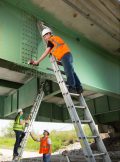With over 600,000 bridges in the United States, bridge safety and longevity is critical to safe transportation in America. By mandate, each bridge is evaluated at least every two years through a process called ‘bridge load rating,’ testing things like endurance and deterioration. But when considering the work put in to inspect every single bridge in the U.S. every two years, bridge load rating as we know it is very labor intensive and potentially costly.
Iowa State University Department of Civil, Construction and Environmental Engineering’s research associate professor Brent Phares has been working on a project for the last year to develop a framework to improve the efficiency of bridge load rating.

“It’s a very big job when you think about the number of bridges that exist and how things are constantly evolving throughout the many years that a bridge is predicted to last,” Phares said. “We want to make sure our estimate of the safe load carrying capacity is the most accurate and the most up to date without being overly labor intensive.”
On top of the load rating that is conducted every two years, there are instances where a unique vehicle needs to cross a bridge, and the bridges on the route need to be evaluated for that special, unique vehicle. Having a process for load rating that is efficient and structured can significantly reduce labor costs and time investment.
The team started a project roughly one year ago, with the help of a $335,000 grant from the Federal Highway Administration to develop a framework for how to improve the efficiency, accuracy and efficacy of bridge load rating and permitting. But Phares has been studying this subject matter for at least a decade, capturing work in two past patents that are currently being licensed.
The possibilities are seemingly endless with this model framework, providing many different conceptual improvements with the potential to even alert truck drivers of a bridge’s load capacity before they reach the bridge.
“One of the things we can do with this is have a process that takes visual inspection results and seamlessly integrates them into a bridge evaluation model – that would be a huge step. Another thing we could do is make bridge models available to truck drivers, so they know what they are driving up to.” Phares said
From the start of bridge load rating, beginning with a person going out to the bridge and looking to identify anything that is suspect or needs repair, to analyzing that data and making changes or by instrumenting select bridges with sensors and data evaluation algorithms, Phares’ model framework covers it all.
“We are developing a framework for the next generation of bridge load rating – how you take information from a visual inspection of the bridge or from bridge sensors, to modifying what an analytical model would look like, to making changes and running calculations,” Phares said. “This project covers every bit of that. We aren’t solving the issues, but we are discovering what you need to do to have an up to date, real-time and accurate system to solve these issues in the future.”
